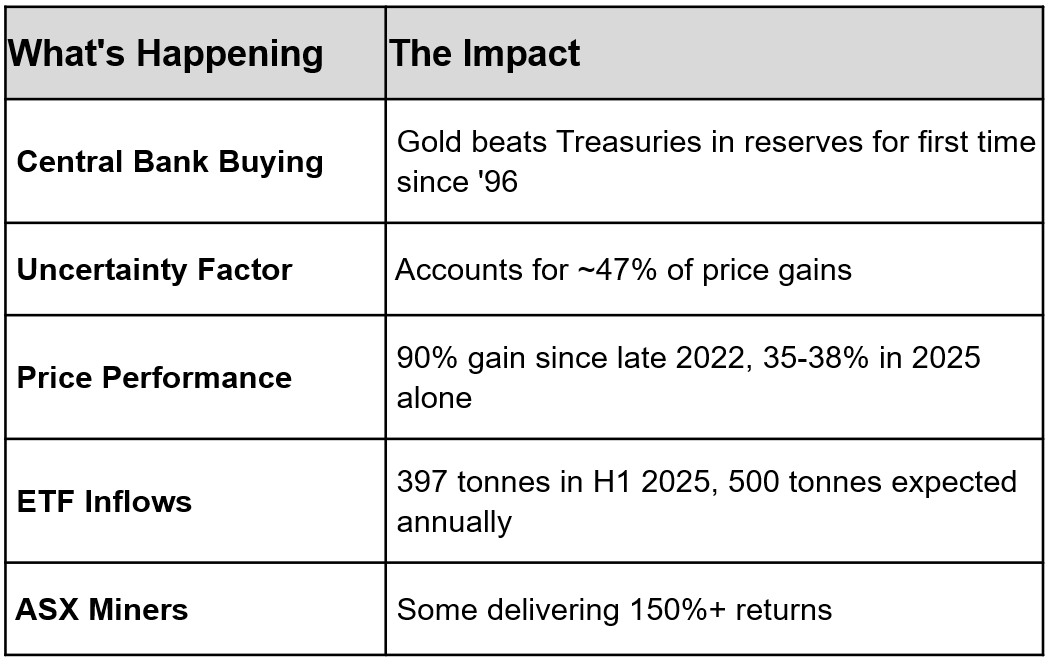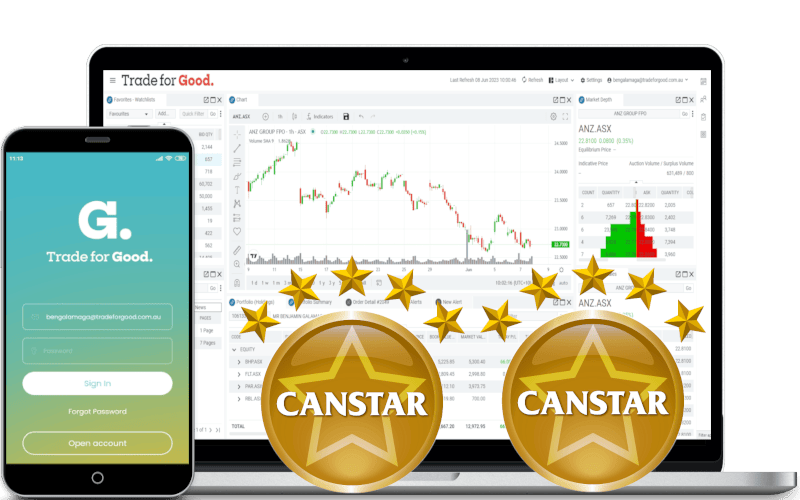The Rise of Gold Prices &
How to Invest with Gold Shares and ETFs
!!!Updated!!!September 2025

Gold futures just smashed through another record, hitting $3,578/oz (as at 01/09/2025) – that’s a massive 34% gain for the year and nearly 90% since late 2022. If you bought gold three years ago, you’ve basically doubled your money while the rest of the market has been all over the place.
Gold has long been a safe-haven asset, and recent market trends have seen its price surge. Whether driven by inflation fears, economic uncertainty, or central bank policies, gold remains a popular store of value. But how can investors gain exposure to gold without the hassle of owning physical bullion? Enter Gold ETFs.
Why Is Gold Rising?
Several key factors are fueling the increase in gold prices:
🔹 Inflation & Currency Weakness – As central banks print money to stimulate economies, the purchasing power of fiat currencies declines, making gold an attractive hedge.
🔹 Geopolitical Uncertainty – Economic instability, conflicts, and trade tensions often drive investors toward gold as a risk-off asset.
🔹 Interest Rates & Monetary Policy – When real interest rates are low or negative, the opportunity cost of holding gold decreases, increasing demand.
🔹 Central Bank Buying – Many global central banks are accumulating gold, adding upward pressure to prices.

How Aussie Investors Can Play the Gold Game
Conservative Approach: Stick with physical gold ETFs like GOLD or PMGOLD – you get exposure without the volatility of individual mining stocks.
Aggressive Approach: Pick individual ASX gold miners, but be ready for a wild ride. The upside can be massive (see those 150% gains), but miners can crash just as hard when gold sentiment turns.
Balanced Approach: Mix of gold ETFs for stability and a small position in quality miners like Northern Star or Evolution for upside potential.

How to Invest in Gold with ETFs
Gold Exchange-Traded Funds (ETFs) provide a convenient way to gain exposure to gold without the need for storage or security concerns. Here’s why they are an attractive option:
✅ Liquidity & Accessibility – Gold ETFs trade on stock exchanges, allowing investors to buy and sell like regular shares.
✅ Diversification – A simple way to hedge against inflation and market downturns.
✅ Cost-Effective – Avoid storage fees and insurance costs associated with physical gold.
✅ Variety of Options – Some ETFs directly track gold’s price, while others hold mining stocks or gold futures.

Popular Gold ETFs to Watch
Here are 3 Gold ETF’s to investigate.
 SPDR Gold Shares (GLD)
SPDR Gold Shares (GLD)
SPDR Gold Shares (GLD) is one of the largest and most liquid gold exchange-traded funds (ETFs), designed to track the performance of the price of gold bullion, less the Trust’s expenses. Launched in November 2004, GLD offers investors a cost-effective and convenient way to access the gold market without the need to physically store the metal.
Key Features:
- Expense Ratio: The fund has a gross expense ratio of 0.40%, which covers costs associated with storage, insurance, and management.
- Assets Under Management: As of March 18, 2025, GLD manages approximately $88.24 billion in assets.
- Liquidity: GLD is highly liquid, with an average daily trading volume of around 8.74 million shares, making it accessible for both retail and institutional investors.
Performance Overview:
GLD’s performance closely mirrors that of gold prices. Over the past year, the ETF has delivered a total return of approximately 39.96%, reflecting the significant rise in gold prices during this period.
 iShares Gold Trust (IAU)
iShares Gold Trust (IAU)
Shares Gold Trust (IAU) is a prominent exchange-traded fund (ETF) that seeks to reflect the performance of the price of gold by holding physical gold bullion. Established in 2005, IAU offers investors a cost-effective and convenient means to gain exposure to gold without the complexities of storing physical gold.
Key Features:
- Expense Ratio: IAU has a competitive expense ratio of 0.25%, making it one of the more cost-effective options for gold investment.
- Assets Under Management: As of March 19, 2025, IAU manages approximately $32.96 billion in assets, reflecting its significant presence in the gold ETF market.
- Liquidity: The fund boasts high liquidity, with an average daily trading volume of around 6.3 million shares, allowing for efficient entry and exit positions for investors.
Performance Overview:
IAU’s performance is closely tied to the price movements of gold. Notable performance metrics include:
- 2024: The fund delivered a total return of 26.85%, aligning with the upward trend in gold prices during that year.
- 2023: IAU achieved a return of 12.84%, reflecting moderate growth in the gold market.
- 2022: The fund experienced a slight decline of 0.63%, corresponding with minor fluctuations in gold prices.
 VanEck Vectors Gold Miners ETF (GDX)
VanEck Vectors Gold Miners ETF (GDX)
VanEck Gold Miners ETF (GDX) is a prominent exchange-traded fund that offers investors exposure to global companies primarily involved in gold mining. By investing in GDX, individuals can gain diversified access to the gold mining sector without the need to select individual stocks.
Key Features:
- Expense Ratio: GDX has a net expense ratio of 0.51%, covering management fees and other operational costs.
- Assets Under Management: As of March 18, 2025, GDX manages approximately $13.227 billion in total net assets.
- Liquidity: The fund is highly liquid, with an average daily trading volume of around 18.23 million shares, facilitating efficient entry and exit for investors.
Performance Overview:
GDX’s performance is closely linked to the gold mining industry, which often exhibits leveraged responses to gold price movements. Notable performance metrics include:
- 2024: The fund delivered a total return of 10.63%, reflecting the sector’s response to rising gold prices.
- 2023: GDX achieved a return of 9.96%, corresponding with the gold market’s performance during that year.
- 2022: The fund experienced a decline of 8.98%, aligning with challenges faced by the gold mining sector.
The Numbers Don’t Lie
Here’s why gold has surged so significantly over the past three years—with its price nearly doubling since late 2022, rising over 90%—and the key forces behind this rally.

ASX Gold Miners – The Wild Ride Winners
The ASX gold miners have been absolutely on fire:
- Regis Resources: +150% (yes, you read that right)
- Genesis Minerals: +145%
- Evolution Mining: +123%
- Northern Star Resources: +110%
These aren’t typos – Aussie gold miners have delivered some of the most insane returns on the ASX this year.

Is Now the Time to Invest in Gold?
Gold has historically been a safe-haven asset, offering protection against economic instability, inflation, and currency depreciation. However, deciding whether to invest in gold now depends on several factors, including macroeconomic conditions, interest rates, and market sentiment. Let’s break it down:
1️⃣ The Case for Investing in Gold Now
✅ Inflation Hedge
Gold has long been used to preserve purchasing power during periods of inflation. With global central banks injecting liquidity into the economy and inflationary pressures persisting, many investors view gold as a store of value.
✅ Economic Uncertainty & Market Volatility
Geopolitical tensions, banking crises, and global debt concerns have led to uncertainty in equity and bond markets. During such times, gold often sees increased demand as investors shift away from riskier assets.
✅ Declining or Lower Real Interest Rates
Gold doesn’t yield interest, so when real interest rates (adjusted for inflation) are low or negative, holding gold becomes more attractive compared to bonds or savings accounts. If central banks pause or cut rates, gold prices could rise further.
✅ Weakening U.S. Dollar
Gold tends to perform well when the U.S. dollar weakens because it is priced in USD. If the Federal Reserve signals a dovish policy shift, this could further boost gold prices.
✅ Central Bank Buying
Many central banks, especially in emerging markets, have been increasing their gold reserves to diversify away from the U.S. dollar. This structural demand supports long-term price appreciation.
✅ Diversification & Portfolio Protection
Gold can reduce overall portfolio volatility by acting as a counterbalance to stocks and bonds. During stock market downturns, gold typically holds or gains value.
2️⃣ The Risks & Considerations
⚠️ Short-Term Volatility
Gold prices can experience sharp fluctuations due to speculative trading, interest rate hikes, or changes in investor sentiment. While it tends to be stable over the long term, traders should be prepared for price swings.
⚠️ Rising Interest Rates & Strong U.S. Dollar
If central banks, particularly the Federal Reserve, maintain higher interest rates for longer, gold prices may face headwinds. A stronger dollar typically leads to weaker gold prices.
⚠️ Opportunity Cost
Since gold doesn’t generate dividends or interest, there is an opportunity cost in holding it compared to income-generating investments like stocks or bonds.
⚠️ Market Timing Challenges
Predicting short-term gold movements can be difficult. While it’s a strong long-term hedge, short-term trends can be driven by speculative trading.
The Bottom Line
Gold’s rally isn’t just about pretty charts – it’s driven by some serious structural changes in how central banks, governments, and investors view risk and value. Whether it continues depends on factors mostly outside anyone’s control: geopolitics, inflation, currency movements, and general global stability.
 For Aussie investors, the ASX offers plenty of ways to play gold – from ultra-safe ETFs to high-octane mining stocks that can double your money (or halve it). As always, don’t bet the farm on any single asset class, no matter how shiny it looks.
For Aussie investors, the ASX offers plenty of ways to play gold – from ultra-safe ETFs to high-octane mining stocks that can double your money (or halve it). As always, don’t bet the farm on any single asset class, no matter how shiny it looks.
The golden rule of gold investing: It’s insurance, not a get-rich-quick scheme. Well, unless you’re one of those lucky Regis Resources holders from this year.
What you learn here has been used in our Trade for Good software.
Click on the button to find our software education videos.
You can read more of our educational articles in the Trade for Good Learn section
Trade for Good Learn

 SPDR Gold Shares (GLD)
SPDR Gold Shares (GLD) iShares Gold Trust (IAU)
iShares Gold Trust (IAU)
 VanEck Vectors Gold Miners ETF (GDX)
VanEck Vectors Gold Miners ETF (GDX)